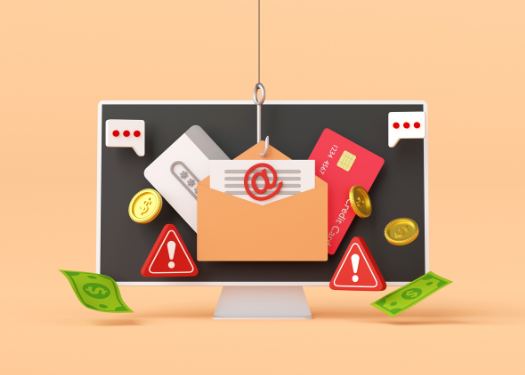How to protect your network from hacking attacks
4 ways on how to stay cyber secure
2 min read
Karina
:
Jan 8, 2024 10:28:36 AM

Phishing attacks are one of the most popular and effective ways for cyber criminals to access private information, with even the most tech-savvy and cautious users being susceptible to its trick. These scams are a massive security challenge to both individuals and businesses alike when keeping information secure. These scams are among the most frequently used forms of cybercrime, especially in the UK. Those who fall victim to a phish attack may find their passwords or credit card details compromised, after clicking on links found in false emails.
Scam artists (phishermen, if you please) typically use common brand names that most people are familiar with, such as Amazon, HMRC or Apple to elicite a false sense of trust. Other tactics include using the names of people you trust (such as the CEO of your company) and identifiable logos, all to make their email look legitimate. Take a look at the scam email below to see just how easy it is to get scammed.
Business phishing scams and attacks are so successful now, that they have been recognised as one of the most common form of cybercrime. More and more individuals and businesses are being targeted as the scams become more complex. The real question this poses, is just how can a business defend its data and assets and prevent phishing?
-3.png?width=497&height=355&name=Copy%20of%20untitled%20(7)-3.png) Security is a top priority for your business – and if it’s not already, it should be. Cyberattacks not only impact your productivity, but more importantly your balance sheet and reputation. In many phishing attacks, the first point of entry is associated with employee error. Clicking on falsified attachments of hyperlinks within emails can compromise the security of your company’s systems.
Security is a top priority for your business – and if it’s not already, it should be. Cyberattacks not only impact your productivity, but more importantly your balance sheet and reputation. In many phishing attacks, the first point of entry is associated with employee error. Clicking on falsified attachments of hyperlinks within emails can compromise the security of your company’s systems.
Although there might not be a step-by-step plan per se, one effective method is to phish your employees. Yes, you read that correctly. You need to phish your own staff.
As mentioned earlier, staff are often the initial point of entry for business phish scams and attacks. By this I mean that employees of a company may receive a seemingly trustworthy email, perhaps even from the ‘CEO’ of their company, requesting them to click on a link or send them confidential information. Who would say no to their CEO?
To get to the heart of the problem, investing in security education for your employees really raises the profile of risk, ensuring that your employees know how to properly deal with phishing scams, keeping security top of mind.
And how do you ensure these staff have been thoroughly educated on how to prevent phishing? Phish them.
By phishing your employees (of course, in a safe and controlled manner), you can have the peace of mind that they really know how to identify and react to phishing emails.
User security training programs such as the ST User Security course provides a comprehensive educational tool to equip your employees with the right knowledge to overcome business phishing attacks.
To find out more, download our ST User Security training guide.

4 ways on how to stay cyber secure

Digital security is important. Selling stolen IDs and other personal data is a lucrative trade for hackers. They are constantly on the look-out for...

In the rapidly evolving digital landscape of 2024, small businesses find themselves at the forefront of a constant battle against cyber threats that...